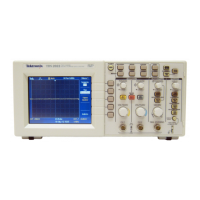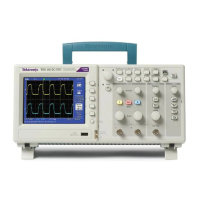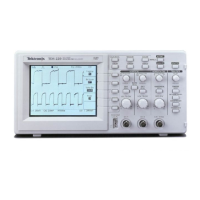Command Syntax
TDS200, TDS1000/2000, TDS1000B/2000B, TPS2000 Programmer
2-7
H If concatenated commands have headers that differ by only the
last mnemonic, you can abbreviate the second command and
eliminate the beginning colon. For example, the commands
ACQuire:MODe AVErage and ACQuire:NUMAVg 16 could be
concatenated into a single command:
ACQuire:MODe AVErage; NUMAVg 16
The longer version works equal ly well:
ACQuire:MODe AVErage;:ACQuire:NUMAVg 16
H Never precede a star (*) command with a colon or semicolon:
ACQuire:MODe AVErage;*TRG
The oscilloscope processes commands that follow the star
command as if the star command was not there, so:
ACQuire:MODe AVErage;*TRG;NUMAVg 16
sets the acquisition mode to average and sets acquisition
averaging to 16. The *TRG command is ignored.
H When you concatenat e que ries, the responses to all queries a re
combined into a single response message. For example, if
channel 1 coupling is set to DC and the bandwidth is set to
20 MHz, the concatenated query:
CH1:COUPling?;BANdwidth?
returns :CH1:COUPLING DC;:CH1:BANDWIDTH ON if header is on,
or DC;ON if header is off.
H You can concatenate set commands and queries in the same
message. For example:
ACQuire:MODe AVErage;NUMAVg?;STATE?
is a valid message that sets the acquisition mode to average,
queries the number of acquisitions for averaging, and then
queries the acquisition state. The oscilloscope executes
concatenated commands and queries in the order it receives
them.













